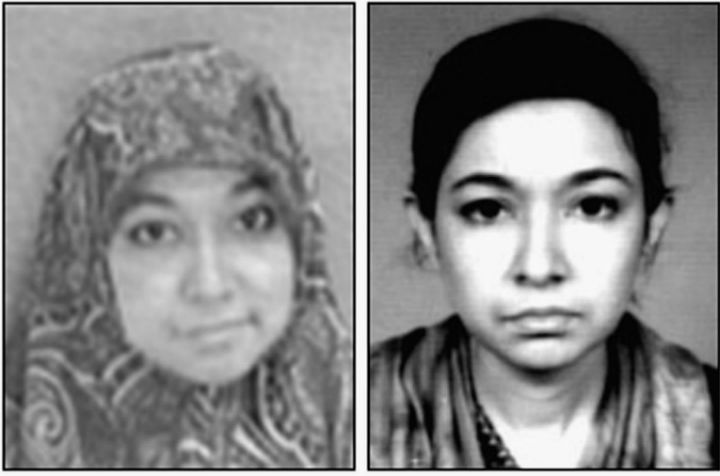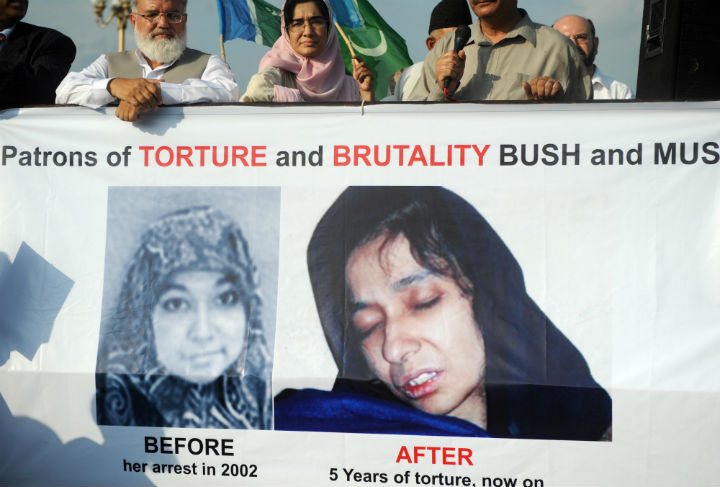Dr. Aafia Siddiqui is sitting behind bars , serving an 86-year sentence in a Texas prison, but her reputation as both “Lady al-Qaeda” and a prisoner of faith has put her at the centre of at least three, high-profile American hostage takings.

The Islamic State (IS) demanded her release, along with an exorbitant ransom and several other conditions, in exchange for setting free captive U.S. journalist James Foley.
None of their demands were met and the extremist group executed him sometime between Aug. 12 and Aug. 19 — the day Foley’s parents received a letter warning he would be executed and the day IS posted a video of the 40-year-old’s beheading online.
The jihadist group referred to her as a “sister” in the letter sent to Diane and John Foley.
READ MORE: Mother of U.S. journalist held by Islamic militants pleads for his release
IS also named Siddiqui, a Pakistani neuroscientist who studied at M.I.T. and Brandeis University, in its demands for the release of a 26-year-old woman who was kidnapped while doing humanitarian work in Syria in 2013 — for whom the militants are also demanding a US $6.6-million ransom.
Before that, the Taliban wanted her freed in exchange for Bowe Bergdahl — the U.S. army sergeant who was held captive for five years, until the U.S. agreed to release five Taliban prisoners from Guantanamo Bay in May.
Why do terrorist groups want Siddiqui freed?
Her arrest and conviction was widely criticized in Pakistan and she was seen as being wrongfully imprisoned.
“One explanation is that people from the Afghan-Pakistan theatre have transferred to Iraq and Syria and her cause is part of their baggage,” Taliban expert Michael Semple told the Telegraph last week.
Foreign Policy referred to her as “Lady al-Qaeda,” referencing allegations she was a facilitator for the terrorist network’s activities and her ties to a 9-11 mastermind.
Siddiqui, now 42, was convicted in 2010 of the attempted murder of U.S. nationals serving in Afghanistan and their Afghan counterparts at a police detachment in Ghazni two years earlier.
She wasn’t tried or convicted for crimes related to terrorism, even though she had been detained when Afghan police discovered her, along with one of her three children, carrying plans for a “mass casualty attack” at U.S. sites, including the Brooklyn Bridge, the Statue of Liberty and the Empire State Building. It’s also alleged she had documents related to using the Ebola virus as a weapon and instructions how to make chemical weapons.
READ MORE: Why ransoms are big business for terrorists and why the U.S. won’t pay
And she was reportedly carrying sodium cyanide when Afghan police arrested her in July 2008, Foreign Policy reported.
According to the Guardian, she had been on the FBI’s radar since 2002 — when agents questioned her and her then-husband, a man named Amjad Khan, about the online purchase of “about $10,000 worth of night-vision goggles, body armour and 45 military-style books.”
She disappeared in 2003 and didn’t resurface until her 2008 arrest,during which time she was listed on the FBI’s Most Wanted List.
Family’s fight for Siddiqui’s freedom
Family members and supporters believe she was actually taken prisoner by the U.S. and held for those five years at the Bagram Detention Centre, outside Kabul, alleging she had been tortured.
Her family is calling for her release, but they want nothing to do with the Taliban and IS calls for her freedom.
“While we deeply appreciate the sincere feelings of those who, like us, wish to see the freedom of our beloved Aafia, we cannot agree with a ‘by any means necessary’ approach to Aafia’s freedom. Nor can we accept that someone else’s daughter or sister suffer like Aafia is suffering,” a letter from Siddiqui’s family, published by ABC News, read.
Her family’s petition to the White House, demanding her repatriation to Pakistan, reached 100,000 signatures earlier this month —meaning the White House has to respond to petition.
“This petition will be presented to President Obama. He may choose to act on it immediately. He may decide to look more closely into the case. He may not choose to act at all. We are hoping and praying that his sense of compassion and justice will guide him and allow Aafia to come home,” a post on the Free Aafia website read.




Comments